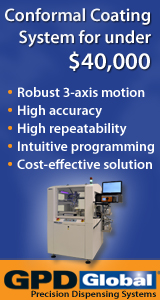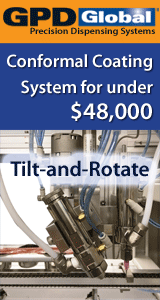With the current RoHS exemptions for high-reliability electronics, it is possible for electronic assemblies to contain lead (Pb) and still be RoHS-compliant. Manufacturers taking the Pb exemption will continue to require SnPb-compatible components for their products, and may also use subassemblies, such as hard disk drives and power modules, that may or may not be Pb-free.
"It is very likely that manufacturers will use subassemblies that contain both tin-lead and lead-free components, which causes reliability concerns due to the differences in processing temperatures and materials," said Thilo Sack, principal engineer, corporate technology, for Celestica Inc. and co-chair of the iNEMI High-Reliability RoHS Task Force. "It is the task force's position that, if RoHS6 subassemblies are to be used in RoHS5 products, the RoHS6 subassemblies should be thoroughly qualified to ensure that they will meet the higher reliability requirements of the RoHS5 products. Furthermore, in some cases, such as BGAs that are internal to RoHS5 or RoHS6 subassemblies, solders and processes should not be mixed. For example, only BGAs with tin-lead solder balls should be used in a tin-lead assembly process, and vice versa - only SAC solder balls in a SAC process."
Some of the additional guidelines and requirements defined by the iNEMI task force include:
* Pb-free Sn finishes on leaded and discrete components should only be used when these finishes (1) include suitable tin whisker mitigation practices, as defined in the IPC/JEDEC joint publication JP002, Current Tin Whiskers Theory and Mitigation Practices Guideline, and (2) have passed Class 2 level tin whisker acceptance testing requirements, as outlined in JEDEC standard JESD-201, Environmental Acceptance Requirements for Tin Whisker Susceptibility of Tin and Tin Alloy Surface Finishes.
* For subassembly modules meeting RoHS5 or RoHS6 requirements, plated leads or pins (the module terminals) that will be attached to the printed circuit assembly should be backward compatible with SnPb assembly processes.
* For RoHS5 or RoHS6 subassemblies, the MSL rating of the module should be based on the worst case MSL rated component used in the module. MSL rating should be provided for SnPb and SAC assembly if applicable to the module. Additionally, the module should meet the temperature requirements of IPC/JEDEC J-STD-020 (revision C or later) for the appropriate SnPb and/or SAC assembly process.
* For RoHS6 subassembly modules (Pb-free module terminals, and the subassembly of the module is built with Pb-free solder and processes) PWBs internal to the module should be manufactured using materials compatible with high-temperature Pb-free soldering. PWB surface finishes also need to be compatible with the Pb-free solder alloy and higher temperature reflow soldering process used.
The complete set of guidelines can be downloaded from:
http://thor.inemi.org/webdownload/projects/ese/High-Reliability_RoHS/High_Rel_position_061206.pdf
ABOUT THE TASK FORCE
The iNEMI High-Reliability RoHS Task Force consists of electronic product manufacturers (OEMs and EMS providers) whose products are characterized by long service life and high-reliability requirements. For these companies, maintaining product reliability is absolutely critical to survival. The following companies support the iNEMI recommendations regarding RoHS5 and RoHS6 modules:
Agilent Technologies, Inc.
Alcatel
Cisco Systems, Inc.
Celestica, Inc.
Delphi Electronics & Safety
HP
Intel Corporation
Jabil Circuit, Inc.
Lucent Technologies
Plexus Corp.
Sanmina-SCI Corporation
Sun Microsystems, Inc.
For additional recommendations and guidelines from the iNEMI High-Reliability RoHS Task Force, please see the following:
Pb-Free Manufacturing Requirements for High-Complexity, Thermally Challenging Electronic Assemblies (2/16/06) http://thor.inemi.org/webdownload/projects/ese/High-
Reliability_RoHS/High_Rel_position_021606.pdf
Recommendations to Electronics Industry Component Supply Base (8/19/05) http://thor.inemi.org/webdownload/projects/ese/High-Rel_RoHS_recommends.pdf
ABOUT iNEMI
The International Electronics Manufacturing Initiative's mission is to assure leadership of the global electronics manufacturing supply chain. Based in Herndon, Va., the industry-led consortium is made up of approximately 70 manufacturers, suppliers, industry associations and consortia, government agencies and universities. iNEMI roadmaps the needs of the electronics industry, identifies gaps in the technology infrastructure, establishes implementation projects to eliminate these gaps (both business and technical), and stimulates standards activities to speed the introduction of new technologies. The consortium also works with government, universities and other funding agencies to set priorities for future industry needs and R&D initiatives. For additional information about iNEMI, visit http://www.inemi.org.
1. RoHS5 modules (5 of 6 RoHS materials) are subassembly modules or products that are RoHS-compliant, but contain Pb (under an applicable RoHS exemption). For example, these products may be soldered with SnPb, and may include soldered component finishes that include Pb.
2. RoHS6 modules (6 of 6 RoHS materials) are subassembly modules or products that are soldered with Pb-free solder and are fully RoHS-compliant (including being Pb-free).
3. Subassembly modules are electronic assemblies consisting of components (mechanical and/or electrical) that are preassembled with solder alloys, with the purpose of being attached or connected to another soldered assembly at a later time.






